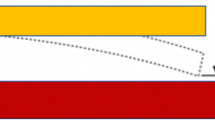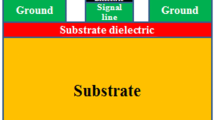Abstract
This paper deals with the study of shunt capacitive RF switches. Comparative study is done on non-uniform designed structures, which are simulated using finite element modelling and HFSS tools. Asymmetric cantilever structures designed along with perforations to achieve less spring constant, low pull in voltage, and isolation performance in OFF state. Asymmetric cantilever structure shows low pull in voltage of 4.1 V for the left cantilever with low spring constant of 0.84 N/m. Right cantilever has a pull in voltage of 4.5 V with a spring constant of 0.86 N/m. The material used on either side of cantilever is gold with the young modulus of 79 GPa. When the RF gap between the cantilever and dielectric is 1.8 um, the capacitance in the up state is 50 fF and in the down state is 4.1 pF for HfO2. Asymmetric cantilever structure has less switching time of 53.2 ns. By using ANSYS HFSS Electromagnetic analysis is done and observed that a high isolation of − 55 dB at 25 GHz is obtained, when both the cantilevers are deforming downwards. The presented asymmetric cantilever switch tunes the isolation between Ku and K bands, − 48, − 50 and − 55 dB at the frequency ranges of 18, 21 and 25 GHz when the left, right and both cantilevers are in OFF-state. The proposed switch has the insertion loss below − 0.05 dB and the return loss has been obtained below − 55 dB over the frequency range of 1–30 GHz.




















Similar content being viewed by others
References
Angira M, Rangra K (2014) Design and investigation of a low insertion loss, broadband, enhanced self and hold down power RF-MEMS switch. J Microsyst Technol. https://doi.org/10.1007/s00542-014-2188-6
Armenta CJA, Porter S, Marvin A (2012) Reconfigurable phased array antennas with RF-MEMS on a PCB substrate. In: Proceeding of antennas and propagation, Loughborough, pp 1–5
Bansal D, Sharma A, Maninder K, Rangra KJ (2012) Design of vertical packaging technology for RF MEMS Switch. In: SPIE8549 16th international workshop on physics of semiconductor devices, pp 854911
Bouchaud J, Knoblich B (2007) RFMEMS switches deliver on early promise. Sens Transducers J 86:1802–1808
Brown ER (1998) RF-MEMS switches for reconfigurable integrated circuits. IEEE Trans Microw Theory Tech 46:1868–1880
Cho IJ, Song T, Baek SH, Yoon E (2005) A low voltage and low-power RF MEMS series and shunt switches actuated by combination of electromagnetic and electrostatic forces. IEEE Trans Microw Theory Tech 53:7
Di Nardo S, Farinelli P, Giacomozzi F, Mannocchi G, Marcelli R, Margesin B, Mezzanotte P, Mulloni V, Russer P, Sorrentino R, Vitulli F, Vietzorreck L (2006) Broadband RF-MEMS based SPDT. Proceeding of European microwave conference, Manchester, pp 1727–1730
Dussopt L, Rebeiz GM (2003) Intermodulation distortion and power handling in RF MEMS switches, varactors and tunable Filters. IEEE Trans Microw Theory Tech 51(4):1247–1256
Entesari K, Rebeiz GM (2005) Differential 4-bit 6.5–10 GHzRF MEMS tunable filter. IEEE Trans Microw Theory Tech 53:1103–1110
Entesari K, Reines IC, Park S-J, El-Tanani MD (2009) Tuning into RF MEMS. IEEE Microw Mag 10:55–72
Fouladi S, Mansour RR (2010) Capacitive RF MEMS switches fabricated in 0.35 μm CMOS technology. IEEE Trans Microw Theory Tech 58:478–485
Giacomozzi F, Calaza C, Colpo S, Mulloni V, Collini A, Margesini B, Farinelli P, Casini F, Marcelli R, Mannocchi G, Vietzorreck L (2008) Development of high Con Coff ratio RF MEMS shunt switches. Roman J Inf Sci Tech 11:143–151
Goldsmith CL, Forehand DI (2005) Temperature variation of actuation voltage in capacitive MEMS switches. IEEE Microw Wirel Components Lett 15(10):718–720
Gong S, Shen H, Barker NS (2009) Study of broadband cryogenic DC-contact RF MEMS switches. IEEE Trans Microw Theory Tech 57:3442–3449
Lacroix B, Pothier A, Crunteanu A, Blondy P (2008) Phase shifter design based on fast RF MEMS switched capacitors. In: Microwave integrated circuit conference, 2008. EuMIC 2008. European. IEEE, pp 478–481
Lakshmi Narayana T, Girija Sravani K, Srinivasa Rao K (2017) A micro level electrostatically actuated cantilever and metal contact based series RF MEMS switch for multi-band applications. Cogent Eng. https://doi.org/10.1080/23311916.2017.1323367
Muldavin JB, Rebeiz GM (2000) High-isolation CPW MEMS shunt switches, part 2: design. IEEE Trans Microw Theory Tech 48(6):1053–1056
Ng KK, Celler GK, Povilonis EI, Frye RC, Leamy HJ, Sze SM (1981) Effects of grain boundaries on laser crystallized poly-Si MOSFET's. IEEE Electron Device Lett 2(12):316–318
Nguyen CTC (2000) Microelectromechanical devices for wireless communications. In: The 11th annual international workshop on micro electro mechanical systems. Heidelberg, Germany, pp 1–7
Peng Z, Yuan X, Hwang JC, Forehand DI, Goldsmith CL (2007) Superposition model for dielectric charging of RF MEMS capacitive switches under bipolar control-voltage waveforms. IEEE Trans Microw Theory Tech 55(12):2911–2918
Peroulis D, Pacheco S, Sarabandi M, Katehi LPB (2000) MEMS devices for high isolation switching and tunable filtering. IEEEMTT-S Microw Symp Dig, Boston, pp 1217–1220
Peroulis D, Pacheco SP, Sarabandi K, Katehi LP (2003) Electromechanical considerations in developing low-voltage RF MEMS switches. IEEE Trans Microw Theory Tech 51(1):259–270
Persano A, Cola A, De Angelis G, Taurino A, Siciliano P, Quaranta F (2011) Capacitive RF MEMS switches with tantalum-based materials. IEEE J Microelectromech Syst 20(2):365–370
Rangra K (2005) Electrostatic low actuation voltage RF MEMS switches for telecommunications. Ph.D., Thesis, Department of Information Technology, University of Trento
Rangra K, Margesin B, Lorenzelli L, Giacomozzi F, Collinni C, Zen M, Gsonicini S, Tin LD, Gaddi R (2005) Symmetric toggle switch a new type of RF MEMS switch for telecommunication applications: design and fabrication. Sens Actuators A123–124:505–514
Rebeiz GM (2003) RF MEMS theory, design and technology, 2nd edn. Wiley, New Jersy
Rebeiz GM, Tan GL, Hayden JS (2002) RF-MEMS phase shifters: design and applications. IEEE Microw Mag 3:72–81
Rebriz GM, Muldavin JB (2001) RF-MEMS switches and switch circuits. IEEE Microw Mag 2:59–71
Sharma AK, Gupta N (2012) Material selection of RF-MEMS switch used for reconfigurable antenna using Ashby’s methodology. Prog Electromagn Res Lett 31:147–157
Sharma A, Dwivedi VK, Singh G (2009) THz rectangular microstrip patch antenna on multilayered substrate for advance wireless communication systems, progress in electromagnetics research symposium, Beijing, China, March 23–27
Srinivasa Rao K et al (2017a) Design and analysis of CPW based shunt capacitive RF MEMS switch. Cogent Eng. https://doi.org/10.1080/23311916.2017.1363356
Srinivasa Rao K et al (2017b) Design and performance analysis of uniform meandered structured RF MEMS capacitive shunt switch along with perforations. Microsyst Technol. https://doi.org/10.1007/s00542-017-3403-z
Tang M, Palei W, Goh WL, Agarwal A, Law LC, Liu AQ (2004) A single-pole double-throw (SPDT) circuit using deep etching lateral metal-contact switches. In: IEEE MTT-S international microwave symposium, pp 581–584
Tilmans HAC, Raedt WD, Beyne E (2003) MEMS for wireless communications from RF-MEMS components to RF-MEMS SiP. J Micromech Microeng 13:S139
Yua AB, Liua AQ, Zhang QX, Alphonesa A, Zhua L, Shacklockc AP (2005) Improvement of isolation for MEMS capacitive switch via membrane planarization. Sens Actuators A 119:206–213
Yua AB, Liua AQ, Zhang QX, Yu AB, Hosseini HM (2006) Effects of surface roughness on electromagnetic characteristics of capacitive switches. J Micromech Microeng 16:2157–2166
Acknowledgements
The Authors would like to thank to NMDC supported by NPMASS, National Institute of Technology, Silchar for providing the necessary computational tools.
Author information
Authors and Affiliations
Corresponding author
Additional information
Publisher's Note
Springer Nature remains neutral with regard to jurisdictional claims in published maps and institutional affiliations.
Rights and permissions
About this article
Cite this article
Rao, K.S., Sailaja, B.V.S., Vineetha, K.V. et al. Design and analysis of asymmetric structure capacitive RF MEMS shunt switch. Microsyst Technol 27, 503–513 (2021). https://doi.org/10.1007/s00542-018-4039-3
Received:
Accepted:
Published:
Issue Date:
DOI: https://doi.org/10.1007/s00542-018-4039-3




